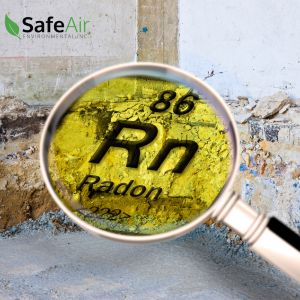Why Radon Testing in High-Rise Buildings is Necessary
Posted in Radon Testing, on July 29, 2024
The SafeAir team helps hundreds of families a year with radon testing. The focus of radon testing is often lower or ground floor levels of single-family or duplex dwellings since this is where it most commonly collects. However, we find that indoor air quality testing in Toronto also detects high levels of radon gas in the upper levels of homes and high-rise buildings too. If you live in this type of building, here’s what you may want to know about testing your apartment or condo for radon.
Radon 101
 If you’ve never bothered to learn about radon because you didn’t think it would affect you on the 21st floor, this section is for you! Radon is a radioactive gas that is created by decaying uranium deep underground. It generally dissipates harmlessly into the atmosphere, but in many buildings, it is attracted to the negative pressure created by basements and lower levels. Once indoors, radon gas cannot easily escape and may build up to toxic levels.
If you’ve never bothered to learn about radon because you didn’t think it would affect you on the 21st floor, this section is for you! Radon is a radioactive gas that is created by decaying uranium deep underground. It generally dissipates harmlessly into the atmosphere, but in many buildings, it is attracted to the negative pressure created by basements and lower levels. Once indoors, radon gas cannot easily escape and may build up to toxic levels.
Radon Affects the Whole Body
High concentrations of radon gas are highly harmful to human health. Everyone is placed at risk by radon regardless of their health or lifestyle because its small particles are colourless, odourless, and invisible to the human eye. Once breathed in, radon continues to decay, bursting in your lungs and soft tissues, causing cellular damage and inflammation.
Radon is the leading cause of lung cancer in Canada, which means you can still get lung cancer without ever smoking a single cigarette. Exposure is cumulative and has few symptoms until it’s too late.
How Radon Moves Out of the Basement
While basements remain the most common area SafeAir tests for radon gas, we’re helping an increasing number of clients who live high in the sky, too. Radon can make its way into condos and apartment buildings in a number of ways, such as:
- Through the water supply, especially in buildings served by well water.
- Emanating from accents like granite or stone countertops.
- Stairwells and elevator shafts may move air from lower levels up.
- Decreased ventilation or the lack of air movement.
- Within building materials like concrete.
How to Prevent Radon at Home
The best method to prevent radon is to stop it from coming into the building, which is where radon testing helps. For apartment blocks or condos, this can be done on an individual basis or through your building association.
At SafeAir, we offer long-term radon testing. A passive device is carefully placed in your unit or the lower levels of your building. This machine takes samples over a 3-6 month period, after which we remove it and send it to a lab for analysis. This lengthy testing period helps even out inconsistencies from weather, human activity, and temperature changes, all of which can affect indoor radon levels. Once we have the results, we’ll help you interpret them and come up with a mitigation plan if necessary.
Indoor air quality testing in Toronto is a straightforward method for creating a healthier, safer living environment that is free from radon and other air pollution. To learn more about radon testing in apartments or high-rise buildings, contact the SafeAir team today.

